Inside CJE September 2024
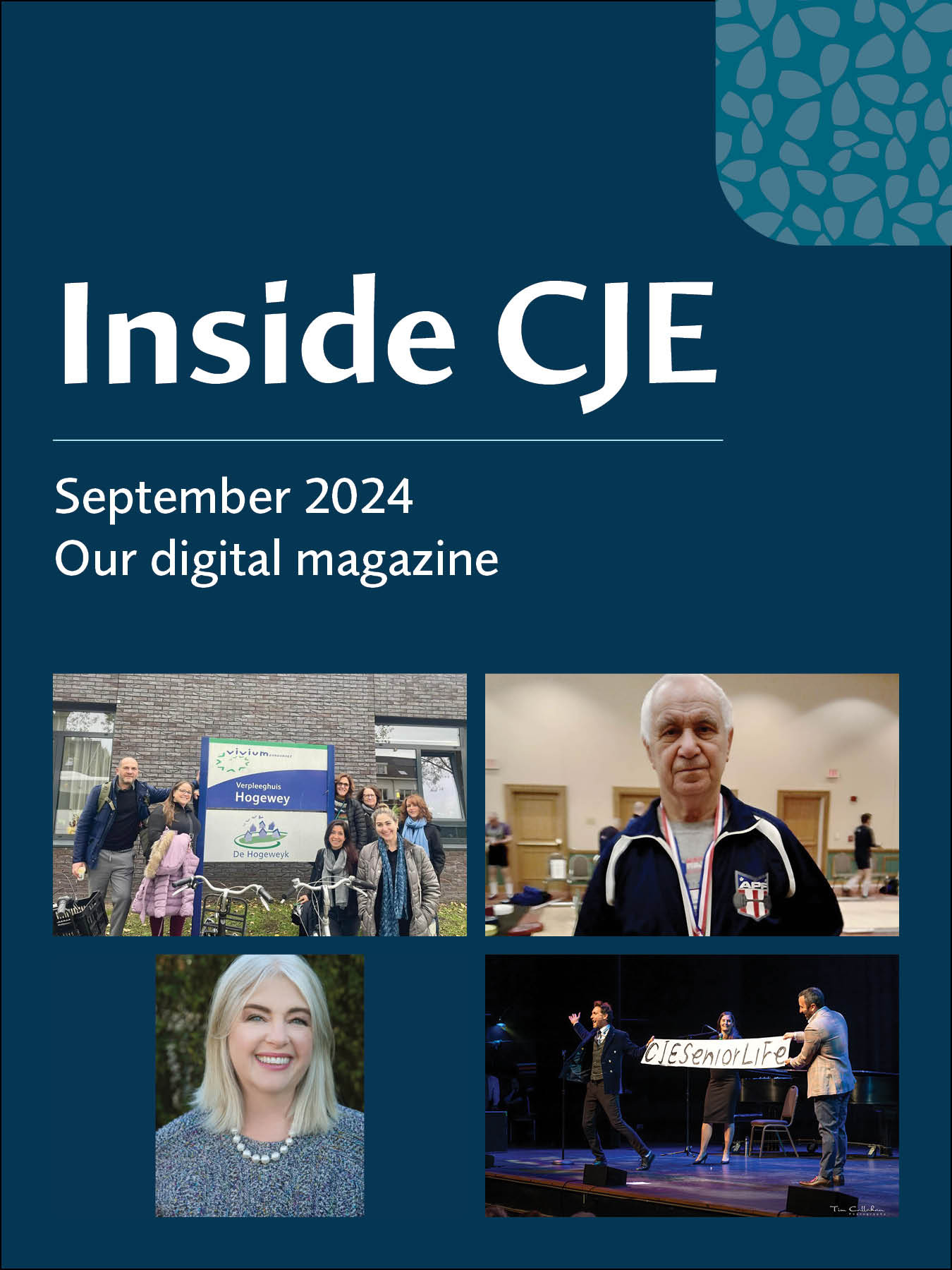
We are thrilled to present Inside CJE! Our digital digest is packed with exciting news about CJE SeniorLife’s various communities, programs, and services—and delivered straight to your inbox. Find out what’s happening at CJE!
-
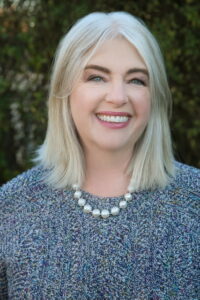
Laura Frankel never met an ingredient she could not work with. “Name an ingredient and I can come up with a pile of recipes that go with it,” she says. Frankel joined Tamarisk as Director of Culinary Operations at the end of 2023 and has made a positive impact.
Dining operations at Tamarisk is no small task. Frankel has 47 people who report to her, including kitchen staff, wait staff, and food vendors. The kitchen prepares and serves nearly 300 meals per day, mostly at dinner, but breakfast and lunch as well. There are special holiday meals and a large Sunday brunch too.
Trained as a savory and pastry chef, at Le Cordon Bleu and The French Pastry School, Frankel has written two cookbooks, founded and ran the Shallots restaurants in Chicago, Skokie, and New York, and recently worked as a product development specialist at The Spice House. She is the food columnist for Jewish Chicago: The JUF Magazine, which includes recipes for everyday eating and holidays, as well as background and history about the dishes.
At Tamarisk, Frankel is revamping the menus, with input from the residents’ Culinary Committee. She has held a tasting event, to get their feedback. She is determined not to serve ho-hum institutional food. “I’m looking at modern, trendy food that’s seasonal and delicious,” she says.
Frankel truly sees the big impact that her job can make on the residents. “I feel like each meal, you have an opportunity to really make someone’s day,” she says. “Sometimes, people are going through a lot, but you might just hit the right spot with fish or a bowl of soup. This is an opportunity to give back a little bit.”
Here’s an easy, favorite recipe of Chef Frankel, that residents can make at home and use as a delicious substitute for mayonnaise or as a dip or garnish:
Laura Frankel’s Tzatziki Sauce
10 minutes
Tzatziki is a creamy, tangy, and all-purpose sauce. Made from Greek yogurt and stirred together with a few simple ingredients, it is a robust dip, sauce, garnish, salad condiment and more.
What will you do with your Tzatziki?
Ingredients:
- 1 English cucumber (this cuke is less watery than a regular cuke), grated or processed in a food processor and set over a strainer for 10 minutes to let water drain out
- 2-3 cloves garlic, grated or finely minced
- Lemon zest and 1 tablespoon fresh lemon juice
- 2 teaspoons red wine vinegar
- 1 tablespoon good quality extra virgin olive oil
- 2 cups Greek yogurt (full-fat works best)
- 2 tablespoons chopped fresh mint
- Pinch of sea salt
Stir all ingredients together in a mixing bowl.
Store covered, in refrigerator, for up to 5 days.
-
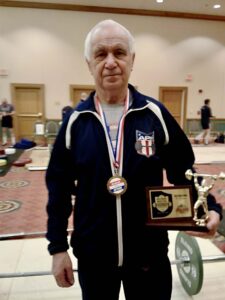
If Iosif Plagov had never heard of weightlifting, he would still have led an extraordinary life. The 90-year-old was born in Belarus in 1935, escaped the Nazis with his family and ended up in Uzbekistan, where he lived from age six to eight. It was not an easy life—food was scarce, and his older sister succumbed to starvation. From Uzbekistan, the family relocated to Ural, where he lived, went to school, worked, and eventually married and started a family.
During his youth, Plagov was athletic, competing in weightlifting and gymnastics. Unfortunately, he suffered a back injury and had to stop practicing sports. He focused on school, earning a PhD in metallurgical sciences, and worked and taught for many years in that field.
In 1997, Plagov and his family came to Chicago, as refugees, and seeking medical treatment for his daughter, who had cancer. His beloved daughter passed away about nine years ago, but his grandchildren and even two great grandchildren live nearby. His son lives in Jerusalem, with two more grandchildren.
In Chicago, Plagov came to CJE’s Holocaust Community Services, which works with over 1,800 Holocaust survivors who live in the Chicago area, offering financial and nonfinancial support, including counseling, companionship, and many other essential services.
Some years ago, someone suggested to Plagov that he try weightlifting again. He had suffered from a number of health problems and was worried about exacerbating his old back injury. But he tried it, working with a bench press, and added weight gradually. He also started cold water swimming, and regularly heads over to Lake Michigan to train there. Little by little, Plagov built up his capacity to lift and to swim. He entered competitions, and then started to win. So far, he has completed competitions around the U.S. and abroad, in Japan, Israel, Finland, England and the Czech Republic.
His weightlifting has helped him overcome a number of health issues, he says, and while his doctor urges him to do more cardio, he focuses on what he likes to do. “Sports helps me to survive,” he says. “I can’t do treadmill, I can’t run. What I do, I swim in the cold water and I do weights.”
In early March, Plagov went to Estonia for another competition. In early March, Plagov went to Estonia and became a World Champion at the Winter Swimming World Championship. He travels independently and has no plans to slow down. He is looking for a sponsor, to help defray the costs of training and travel, but in the meantime, he plans to keep living his personal motto: “Inspire before you expire.” Which he does, every day.
-

If you or a loved one has hoarding tendencies, know that you are not alone. Hoarding is not just a behavior. It is a recognized neurological disorder, characterized by a person’s acquiring and retaining large numbers of possessions to decrease anxiety or distress, according to the most recent edition of the Diagnostic and Statistical Manual of Mental Disorders (DSM). A person who hoards may have some insight into the downside of the behavior, or may be in complete denial about it [source: https://www.ncbi.nlm.nih.gov/books/NBK519704/table/ch3.t29/].
Hoarding is a huge issue, affecting some 19 million adults in the U.S., according to some estimates. Who is most at risk for hoarding behaviors? People of all ages can experience hoarding disorder, but it is more common among adults over the age of 55. “It’s not necessarily an age-related experience, but it can get worse as people get older,” says Anna Schloen, LCSW, manager of Care Management Services at CJE. “It can also be a coping mechanism for people who have experienced trauma, such as domestic violence or homelessness, and it progresses over time to become unmanageable,” she adds.
Because hoarding can be so challenging, CJE has partnered with other agencies and organizations in the community to address it. “It’s a bigger problem than any one person can solve,” Schloen says. “CJE has connections in the community to help with the practical details of cleanouts and we are sometimes able to offer some funding for deep cleaning. We try to group together funding and support from the state or other social services organizations to help.”
CJE has revitalized a hoarding disorder task force in north suburban Chicago. The task force meets every other month to discuss issues around hoarding and share resources. They have recently created a resource guide for individuals who need assistance with managing hoarding disorder, which is available on the Care Management page on www.cje.net.
If you or a loved one needs help with hoarding disorder issues, contact CJE SeniorLife for more information and guidance.
-

Last October, Sharon Dornberg-Lee, LCSW and Yonit Hoffman, PhD traveled to the Netherlands to visit a very special place—Hogeweyk. This community is well known for its model of caring for people with dementia. “We really wanted to see firsthand what this model looks like in practice,” says Dornberg-Lee. “And we wanted to think about some of the ways in which we might apply, if not the model itself, some of these concepts.”
The trip was sponsored by the European Council of Jewish Communities and the Network of Jewish Human Services Agencies, and generously funded by The Sephardic Foundation on Aging. It brought together approximately 25 people from around the US and other European countries as well. And because CJE is on the forefront of caring for adults who have been through trauma, Dornberg-Lee and Hoffman were invited to give a presentation entitled Holocaust Survivors & Dementia: What We Know and Best Practices, centering on current research at the intersection of trauma and dementia.
Hogeweyk truly is a model memory care/skilled nursing community. It focuses on fostering independence and dignity among its residents. “We saw many people who had complete freedom of movement around this campus. There were little storefronts, cobblestones, this charming appearance of a little village and there was lots of communal life going on,” recalls Dornberg-Lee.
Independence and less medication were two themes that quickly became clear to Dornberg-Lee and Hoffman. “They don’t medicalize dementia, they try to really normalize it,” Hoffman explains. “The residents of this memory care village are free to stroll the campus, sit outside, and engage in a large array of activities. They live in 27 smaller communities, or houses, and they work together to meet their needs, such as food shopping and preparing meals. These activities help them engage in their surroundings and experience a sense of accomplishment.”
“We need to open ourselves up to this philosophy,” says Dornberg-Lee. “We see all the negative sides of an overly medical model of aging, over-reliance on medications, over-focus on avoiding risk, avoiding injury. That can lead to a diminished quality of life.”
Dornberg-Lee and Hoffman are sharing what they learned with their colleagues at CJE, and will brainstorm on how some of the information and experiences they witnessed could apply in CJE programming.
-
On September 17, we hosted our 19th Celebrate CJE! Over 500 people joined us at the North Shore Center for Performing Arts for our biggest event of the year, supporting older adults and their families. The evening featured a beautiful reception, an engaging program, and incredible entertainment by Master Mentalist Lior Suchard. Thank you to everyone who attended and participated! Here are some photos from the evening. View more photos.

Lior Suchard, Master Mentalist 
Dan Fagin, President & CEO, CJE SeniorLife 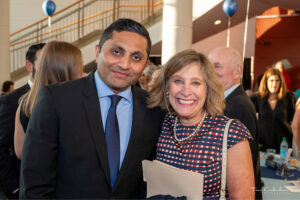
Ameya Pawar, President & CEO, Gayla Brockman, Executive Vice President, Michael Reese Health Trust 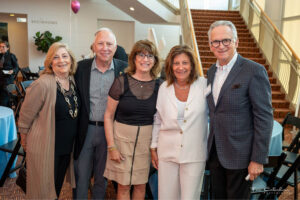
Allan Goldstein (far right), Board Member, CJE SeniorLife and guests.



